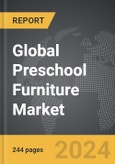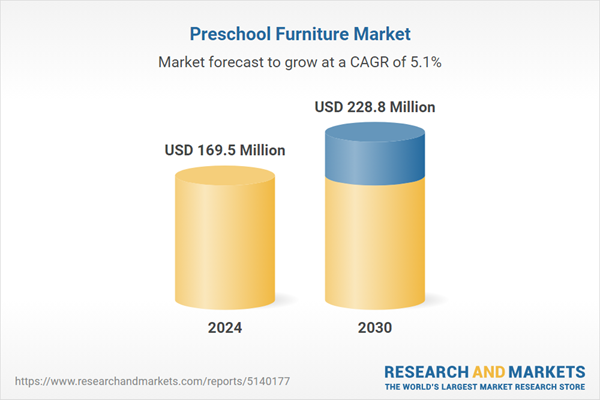The global market for Preschool Furniture was valued at USD 169.5 Million in 2024 and is projected to reach USD 228.8 Million by 2030, growing at a CAGR of 5.1% from 2024 to 2030. This comprehensive report provides an in-depth analysis of market trends, drivers, and forecasts, helping you make informed business decisions.
Global Preschool Furniture Market - Key Trends and Drivers Summarized
Preschool Furniture: Creating Safe and Engaging Learning Environments
Preschool furniture refers to the specialized furniture designed for early childhood education settings, such as daycare centers, kindergartens, and nursery schools. This furniture is specifically designed to meet the needs of young children, providing them with safe, comfortable, and developmentally appropriate spaces for learning, play, and social interaction. Key pieces of preschool furniture include child-sized tables and chairs, storage units, activity centers, and rest areas. The importance of preschool furniture lies in its role in creating an environment that supports the physical, cognitive, and emotional development of young children. Well-designed furniture not only ensures the safety and comfort of children but also encourages exploration, creativity, and collaboration, making it an essential component of early childhood education.How Are Technological Advancements Enhancing Preschool Furniture?
Technological advancements have significantly improved the design, functionality, and safety of preschool furniture, making it more adaptable to the needs of modern educational environments. Innovations in materials science have led to the development of furniture made from durable, non-toxic, and easy-to-clean materials, ensuring that the furniture can withstand the wear and tear of daily use while maintaining a safe environment for children. Ergonomic design principles have been increasingly applied to preschool furniture, creating pieces that support proper posture and movement, promoting physical health and comfort for young children. Additionally, the integration of modular and flexible furniture systems has enhanced the adaptability of preschool spaces, allowing for easy reconfiguration of classrooms to support different activities and learning styles. The use of digital design tools has also enabled the creation of customized furniture solutions that meet the specific needs of individual schools and childcare centers. These technological improvements have made preschool furniture more functional, safe, and conducive to the developmental needs of young children.What Are the Key Applications and Benefits of Preschool Furniture?
Preschool furniture is used in various early childhood education settings, offering numerous benefits that enhance the learning and development of young children. In classrooms, child-sized tables and chairs provide a comfortable and accessible space for children to engage in group activities, art projects, and lessons. Storage units and cubbies help organize classroom materials and personal belongings, promoting independence and responsibility among children. Activity centers and play structures offer opportunities for imaginative play, sensory exploration, and physical activity, supporting the holistic development of children. Rest areas with soft furnishings provide a safe and cozy space for children to relax and recharge, contributing to their emotional well-being. The primary benefits of preschool furniture include its ability to create a safe, engaging, and supportive learning environment, promote physical and cognitive development, and foster social interaction and collaboration among children. By providing age-appropriate and well-designed furniture, preschools can create environments that nurture the growth and development of young learners.What Factors Are Driving the Growth in the Preschool Furniture Market?
The growth in the preschool furniture market is driven by several factors. The increasing emphasis on early childhood education and the expansion of preschool and childcare facilities are significant drivers of demand for high-quality preschool furniture. Technological advancements that improve the safety, durability, and functionality of furniture are also propelling market growth. The growing awareness of the importance of creating child-friendly learning environments that support developmental needs is further boosting the demand for specialized preschool furniture. Additionally, the rise in government initiatives and investments in early childhood education, particularly in developing regions, is contributing to market expansion. The increasing focus on sustainability and the use of eco-friendly materials in furniture manufacturing are also influencing consumer preferences and driving market growth. These factors, combined with continuous innovation in furniture design and materials, are driving the sustained growth of the preschool furniture market.Report Scope
The report analyzes the Preschool Furniture market, presented in terms of market value (USD Thousand). The analysis covers the key segments and geographic regions outlined below.Segments
Product (Seating, Tables).Geographic Regions/Countries
World; United States; Canada; Japan; China; Europe (France; Germany; Italy; United Kingdom; Spain; Russia; and Rest of Europe); Asia-Pacific (Australia; India; South Korea; and Rest of Asia-Pacific); Latin America (Argentina; Brazil; Mexico; and Rest of Latin America); Middle East (Iran; Israel; Saudi Arabia; United Arab Emirates; and Rest of Middle East); and Africa.Key Insights:
- Market Growth: Understand the significant growth trajectory of the Seating Furniture segment, which is expected to reach $164.6 Million by 2030 with a CAGR of a 5.8%. The Tables segment is also set to grow at 3.5% CAGR over the analysis period.
- Regional Analysis: Gain insights into the U.S. market, valued at $45.1 Million in 2024, and China, forecasted to grow at an impressive 8.7% CAGR to reach $50.4 Million by 2030. Discover growth trends in other key regions, including Japan, Canada, Germany, and the Asia-Pacific.
Report Features:
- Comprehensive Market Data: Independent analysis of annual sales and market forecasts in USD from 2024 to 2030.
- In-Depth Regional Analysis: Detailed insights into key markets, including the U.S., China, Japan, Canada, Europe, Asia-Pacific, Latin America, Middle East, and Africa.
- Company Profiles: Coverage of major players such as GonzagArredi Montessori Srl, Guangzhou Everpretty Furniture Co., Ltd., Intermetal SA, Jonti-Craft Inc., KI and more.
- Complimentary Updates: Receive free report updates for one year to keep you informed of the latest market developments.
Why You Should Buy This Report:
- Detailed Market Analysis: Access a thorough analysis of the Global Preschool Furniture Market, covering all major geographic regions and market segments.
- Competitive Insights: Get an overview of the competitive landscape, including the market presence of major players across different geographies.
- Future Trends and Drivers: Understand the key trends and drivers shaping the future of the Global Preschool Furniture Market.
- Actionable Insights: Benefit from actionable insights that can help you identify new revenue opportunities and make strategic business decisions.
Key Questions Answered:
- How is the Global Preschool Furniture Market expected to evolve by 2030?
- What are the main drivers and restraints affecting the market?
- Which market segments will grow the most over the forecast period?
- How will market shares for different regions and segments change by 2030?
- Who are the leading players in the market, and what are their prospects?
Some of the 41 major companies featured in this Preschool Furniture market report include:
- GonzagArredi Montessori Srl
- Guangzhou Everpretty Furniture Co., Ltd.
- Intermetal SA
- Jonti-Craft Inc.
- KI
- Smith System Mfg. Co
- Virco Inc.
- VS America, Inc.
- Whitney Brothers
Table of Contents
I. METHODOLOGYII. EXECUTIVE SUMMARY2. FOCUS ON SELECT PLAYERSIII. MARKET ANALYSISIV. COMPETITION
1. MARKET OVERVIEW
3. MARKET TRENDS & DRIVERS
4. GLOBAL MARKET PERSPECTIVE
UNITED STATES
CANADA
JAPAN
CHINA
EUROPE
FRANCE
GERMANY
ITALY
UNITED KINGDOM
SPAIN
RUSSIA
REST OF EUROPE
ASIA-PACIFIC
AUSTRALIA
INDIA
SOUTH KOREA
REST OF ASIA-PACIFIC
LATIN AMERICA
ARGENTINA
BRAZIL
MEXICO
REST OF LATIN AMERICA
MIDDLE EAST
IRAN
ISRAEL
SAUDI ARABIA
UNITED ARAB EMIRATES
REST OF MIDDLE EAST
AFRICA
Companies Mentioned (Partial List)
A selection of companies mentioned in this report includes, but is not limited to:
- GonzagArredi Montessori Srl
- Guangzhou Everpretty Furniture Co., Ltd.
- Intermetal SA
- Jonti-Craft Inc.
- KI
- Smith System Mfg. Co
- Virco Inc.
- VS America, Inc.
- Whitney Brothers
Table Information
| Report Attribute | Details |
|---|---|
| No. of Pages | 244 |
| Published | April 2025 |
| Forecast Period | 2024 - 2030 |
| Estimated Market Value ( USD | $ 169.5 Million |
| Forecasted Market Value ( USD | $ 228.8 Million |
| Compound Annual Growth Rate | 5.1% |
| Regions Covered | Global |









